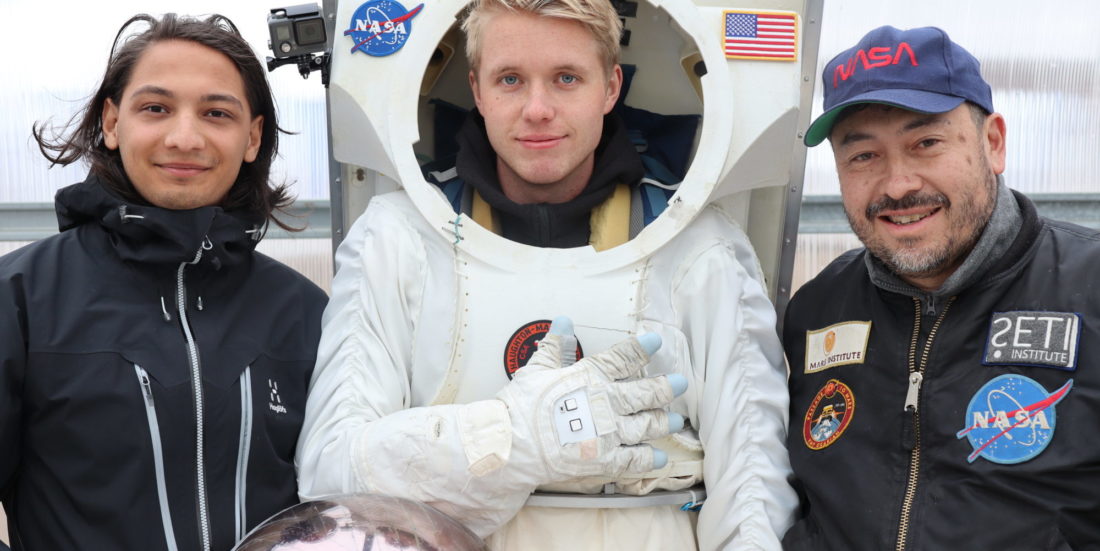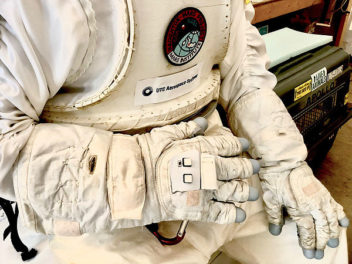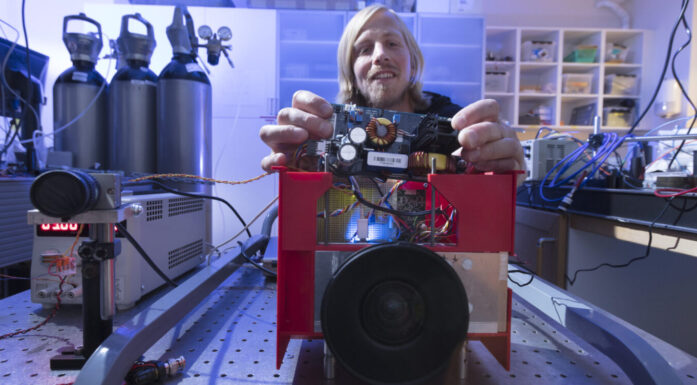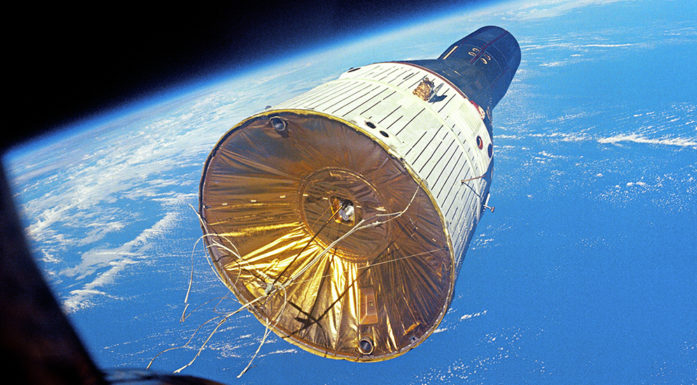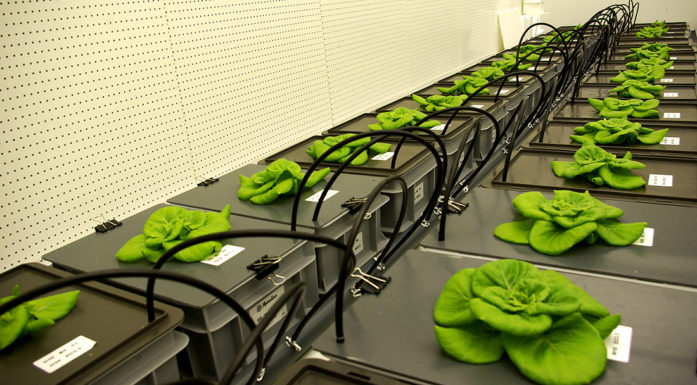Ground-breaking astronaut glove for exploring the moon and Mars
NTNU students have developed a smart glove for astronauts that can be used while exploring other planets. NASA partners recently conducted successful testing of the glove at the Haughton Mars Project research station.
The start-up company Ntention, with NTNU roots, has developed the design and technology behind a smart glove for astronauts. The business partners describe the smart glove as ground-breaking for future human exploration of the moon, Mars – and possibly even other planets.
NASA plans to return to the moon by 2024 with the Artemis programme, and then send astronauts to Mars. As a result of the start-up’s project with NASA, astronauts may be equipped with Norwegian-developed smart gloves from Ntention.
The human-machine interface technology behind the glove enables communicating with machines via the body. The glove allows astronauts to control drones or other robots using simple hand gestures.
The company Ntention today consists of 13 NTNU students, mainly from industrial economics, cybernetics and robotics, as well as industrial design.
Mars on Earth
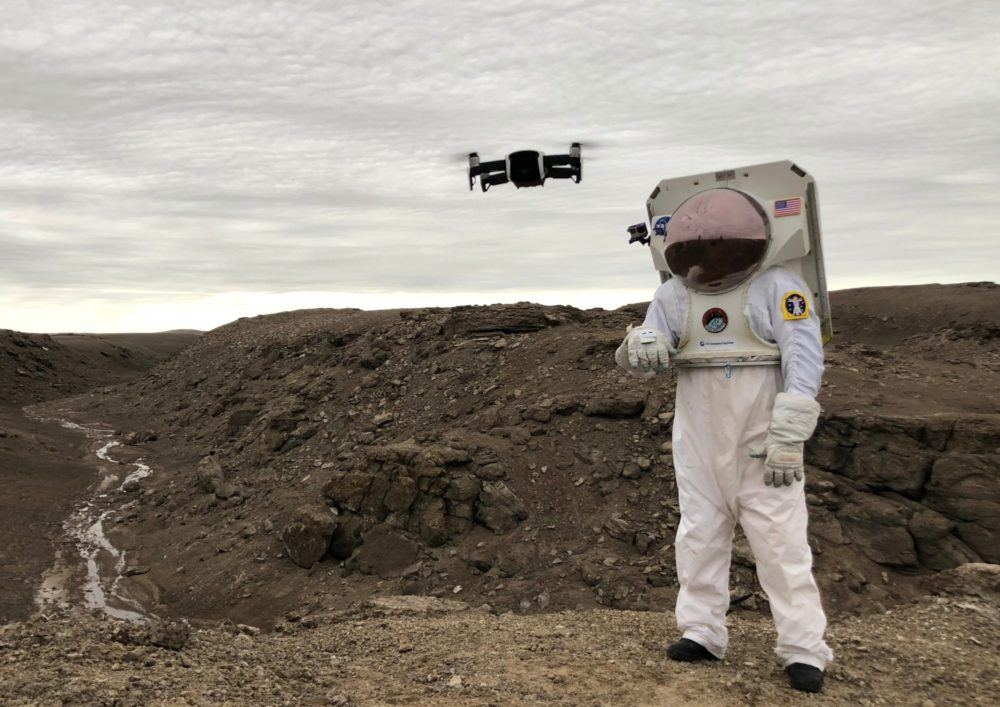
The glove makes controlling drones more flexible and precise. Here it is being tested on Devon Island. Photo: Haughton-Mars Project
The NASA Haughton-Mars Project recently field tested the students’ smart gloves. The Mars Institute and the SETI Institute report in a news release that the testing was successful.
The NASA Haughton-Mars Project (HMP) is a research facility located on the world’s largest uninhabited island, Devon Island in the Arctic. The place is often called Mars on Earth because of its harsh Arctic climate and because it is one of the most Mars-like places on Earth.
Throughout its 23-year history, NASA HMP has made numerous contributions to advances in space research, especially in testing new technologies for space. Devon Island’s rugged terrain, cold temperatures and isolation provide unique research opportunities – and challenges like you would run into on a long-distance space mission.
Glove gives astronauts good finger dexterity
An astronaut in space operates in a spacesuit that is relatively rigid and unyielding under pressure. In other words, fine motor activities are not particularly easy in a spacesuit. Hand and finger movements meet with considerable resistance, making it difficult for astronauts to perform tasks such as controlling robots and collecting samples.
“A smart glove-equipped spacesuit could be a solution,” says Dr. Pascal Lee in the press release. He is a space scientist at the Mars Institute and director of the NASA Haughton-Mars Project.
- You may also like: Entrepreneurs work to help the world reach climate goals
Seamless function between humans and machines
In the “Astronaut Smart Glove”, the sensitivity of hand motions is adjustable and can be set high.
“Our philosophy is to create technology that makes the human-machine interface intuitive and seamless. With this glove, the astronaut can easily control a variety of robots, making research and exploration of other planets more efficient,” says NTNU student Moina Medbøe Tamuly, co-founder and co-CEO of Ntention.
He was a field participant this summer during the glove testing on Devon Island.
“Now, we’re excited to see that our technology has potential applications for space exploration,” says Tamuly.
- You may also like: Digital glove returns control to conductor
What makes the glove so ground-breaking?
“The smart glove uses a microcontroller to read different kinds of sensors,” says NTNU student Sondre Tagestad. He is the system development engineer at Ntention and was a field participant at the test station on Devon Island, where he was the technical leader for hardware and software in the prototype “Astronaut Smart Glove.”
“The sensors capture even subtle motions of the hand and fingers and wirelessly transfer them to a mobile device that controls the drone or any other robot.
Next generation spacesuits
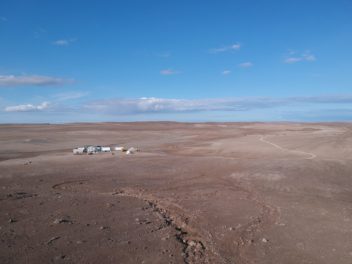
The research station on Devon Island is located in a unique environment that is perfect for testing new technologies for space. Photo: Haughton-Mars Project
“Astronauts need spacesuits that make it easy for them to interact with their environment, including performing complex and delicate tasks,” says Dr. Greg Quinn, head of Advanced Spacesuit Development Lead at Collins Aerospace, which is working with NASA on the development of future spacesuits.
The Devon Island testing team evaluated the “Astronaut Smart Glove” technology through a series of field trials involving remote drone operations.
Astronauts on the Moon or Mars could use drones for mapping, to collect samples that are out of reach of the astronauts, or to assist in search and rescue operations.
The field tests demonstrated how an astronaut in a spacesuit could easily perform several important research tasks using the smart glove and an augmented reality (AR) visualization interface.
View the full Mars Institute news release here.
Intense student entrepreneurial environment
The students behind Ntention spend their days at Gründerbrakka on the Gløshaugen campus in Trondheim – when they aren’t on work trips around the world, in lectures or studying. However, according to Tamuly, he spends most of his time working on developing the company and the technology.
Gründerbrakka is NTNU’s relatively new workplace for student entrepreneurs. Here the energy is young, ambitious, playful and intense, and here the innovations of the future are being created.
Gründerbrakka houses over 50 student entrepreneurs in nine start-ups, and it facilitates the transition from student to full-time entrepreneur.
“It’s because of the ecosystem around innovation at NTNU and in Oslo that we’ve come as far as we have. Being able to connect with the right people is crucial,” says Tamuly.
- You may also like: The professor who misses his tail
Entry into the top level
The glove technology start-up company was established by Magnus Arveng in 2016. Today, twelve NTNU students and one former student are working on further development.
How on earth did the student team catch the eye of the leading international space research community?
“What we’re working on is sufficiently visionary that it’s essential for us to build solid networks. That’s why we attend a number of conferences. At last year’s Energy Valley conference at Fornebu, we got to pitch our project and have a table there; they wanted some young blood,” says Tamuly.
Pascal Lee, director of the NASA Haughton-Mars Project, gave a talk at the conference, and when Lee learned what the students were working on, it was an instant match between Lee and the students.
Suddenly, the team had the opportunity to test their astronaut glove with some of the leading international space researchers.
It took seven months of hard work before they could bring their enhanced and adapted glove technology to Devon Island this past summer.
“Being allowed to be part of the Devon Island testing was absolutely magical. Not only that, we were even allowed to baptize our own ‘Ntention Hill,’” Tamuly says.
- You may also like: This technology will transform you into Superman
Machines that understand humans
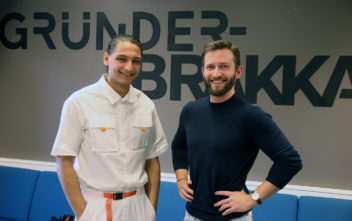
Moina Medboe Tamuly (at left) is co-founder and technical manager of Ntention, and Frank Øygard works on product and development strategy in Ntention. Photo: Idun Haugan / NTNU
“We call this the future interaction between humans and machines,” says Frank Øygard. He works with product and development strategy in Ntention.
“We’re working to develop technology that lets machines understand humans, rather than humans being able to use and understand how machines work,” says Øygard.
A lot of researchers have been working on this idea for quite some time, but according to the team, it has been difficult to achieve this in an effective way.
“Technology has been missing an important link, and we’re building the link between computers and humans,” says Tamuly.
To achieve this, Ntention is creating smart software that analyses people’s actions and movements and then translates them so that the machine can interpret the information.
Possible paradigm shift
“We believe that the technology we’re developing could represent a paradigm shift. Our system is much more intuitive than the rigid controller used in a lot of contexts. We’re able to incorporate more sensors and more data into our glove technology and scale it all up so that the glove becomes a finely tuned controller,” says Fran Øygard.
“Over time, we can include other types of sensors and build interaction systems that can handle increasingly complex tasks,” he adds.
The founders say that the technology can be used in many contexts, not just for space applications. The construction industry is an example of another field it can prove useful for.
In this area, Ntention has worked closely with Norconsult, where they have replaced conventional VR controllers with gloves. These gloves allow the user to interact with building models in VR in a more intuitive way. You can touch walls or columns and get live data about the building, such as what materials were used, for example.
“Actually, the technology can be used in all industries that use VR and AR,” says Øygard.
Watch the video from the testing on Devon Island:
The Haughton-Mars Project (HMP) video shows the “Astronaut Smart Glove” prototype being field tested. Filmed at Haughton Crater, Devon Island, High Arctic.
Partners: Mars Institute, SETI Institute, NASA Ames Research Center, Collins Aerospace and Ntention.
